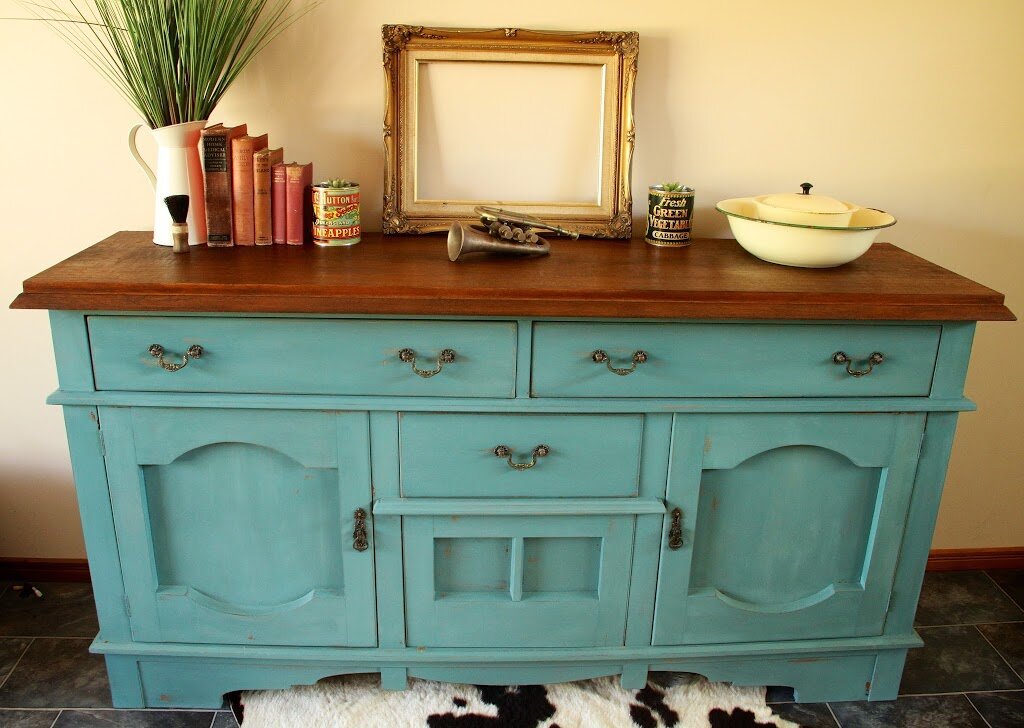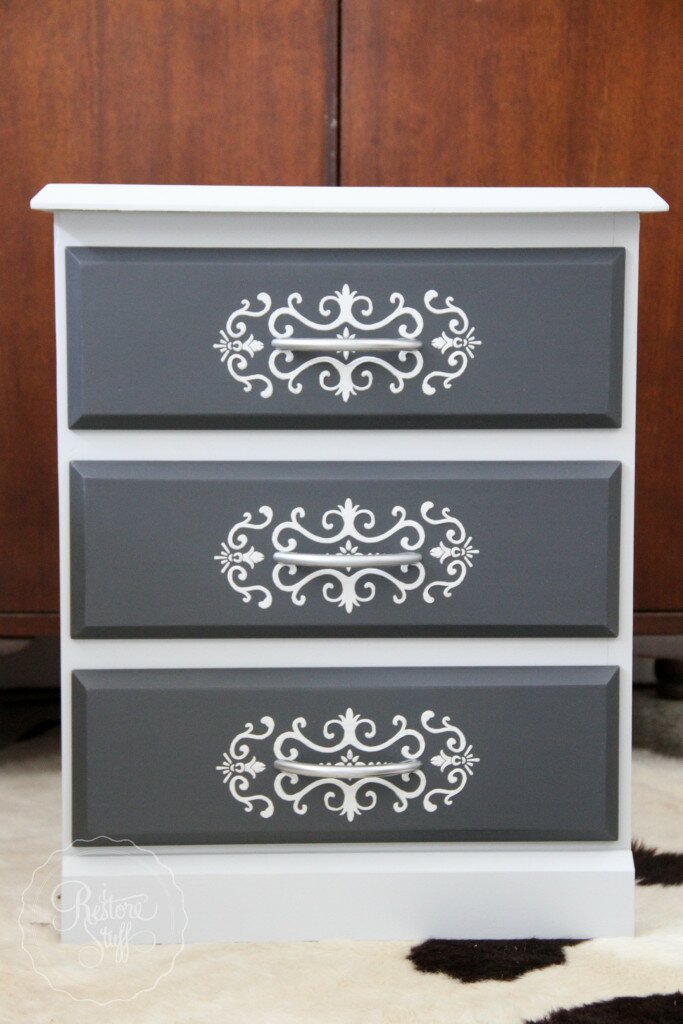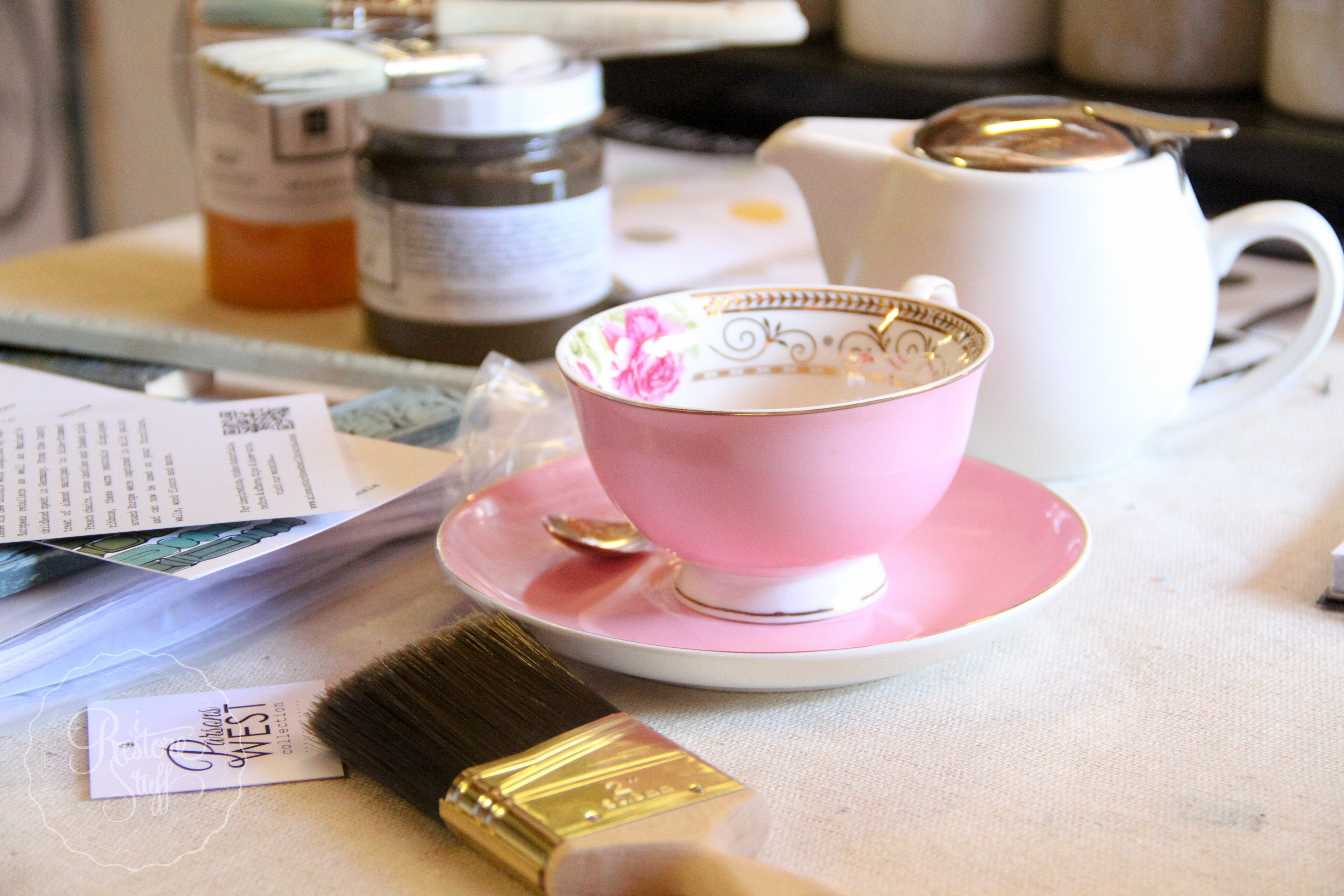Download our quick reference guide comparison between Chalk Paint, Milk Paint & Mineral Paint?
Click Here
I’ve been asked these kind of questions a few more times lately since introducing Fusion Mineral Paint to my line of products. So here’s a summary I’ve put together, and this is only based on my opinion, along with my description of these products. Thrown in the mix, I’ll glean from the manufacturers of these products themselves for further info.
Let me start by saying how much I love painting, and I really do love all these products, but I find that I use them for different pieces I’m working on, for different reasons, and I think that’s all just a matter of personal preference.
Miss Mustard Seed’s Milk Paint:
 I first discovered Miss Mustard Seed’s Milk Paint via Marian Parson’s blog, Miss Mustard Seed, and was excited when she partnered with Homestead House Milk Paint Company in Canada to produce a range of colours for this wonderful age old primitive style paint. I had my sister-in-law send me some from her closest stockist (she lives in the USA), and fell in love with the quality and feel, and the authentic distressed chippy finishes that I could produce, topped with the lovely waxes and hemp oil to finish. It was easy to say yes to being a retailer in Australia for MMSMP, and I’ve made several video tutorials on my experiences with this paint on . You can purchase MMSMP products via the Product tab on my menu bar.
I first discovered Miss Mustard Seed’s Milk Paint via Marian Parson’s blog, Miss Mustard Seed, and was excited when she partnered with Homestead House Milk Paint Company in Canada to produce a range of colours for this wonderful age old primitive style paint. I had my sister-in-law send me some from her closest stockist (she lives in the USA), and fell in love with the quality and feel, and the authentic distressed chippy finishes that I could produce, topped with the lovely waxes and hemp oil to finish. It was easy to say yes to being a retailer in Australia for MMSMP, and I’ve made several video tutorials on my experiences with this paint on . You can purchase MMSMP products via the Product tab on my menu bar.
Product form:
- Powder which is combined with equal parts water to form a smooth, slightly runny mixture, similar to pancake batter.
- Comes in 230gm & sample sachet (30gm) of powder.

Features:
- little need to prime or strip surfaces – very little prep required.
- self levelling, meaning you won’t see brush marks – the paint levels as you apply it to a surface.
- very quick drying – dries to a porous, chalky finish.
- needs to be finished or sealed with a wax or oil for best results.
- can be used on many surfaces, but will often result in a naturally chippy or flakey finish on more glossy or certain types of surfaces, unless a bonding agent is added.
- can be sanded back and distressed very easily for an authentic chippy or aged patina.
- only have to mix as much as required for each project.
- 24 colours to choose from.
- all natural ingredients used, including the pigments. ie. completely eco friendly.
- 2-3 coats needed for good coverage.
- a 230g packet mixes to create approx 460ml paint, which covers approx 15m² (if covering a dark surface with light colour you will need more coats)
- wash brushes out in water. Can use MMSMP Brush Soap for excellent results.

A sideboard painted in MMSMP Kitchen Scale
When do I love to use Milk Paint?
- on antique pieces that lend to a lovely distressed chippy finish.
- for an authentic French Country cottage or rustic feel, especially when using the white colours.
- as a wash or stain to bring out the grain details in a piece of timber especially on the top surfaces of dressers or table tops. (ratio for stain: 1 powder:3 water)
- for a layered, farmhouse look using two colours.
- for a smooth modern look when adding the bonding agent.
Fusion Mineral Paint:
This is a fairly new product on the market, but the family owned company, Homestead House, have taken over 10 years to develop, test and refine this amazing paint. You can read more in-depth features on their website here. I love using it, and all the extra products that compliment their range, like the Transfer Gel, Gilding pastes and more. I have added the Fusion brand to my list of products which you can find under the product tab on this website.
But here are the basics:
Product Form:
- ready made paint formula in a clear plastic jar, with a consistency similar to latex paints.
- comes in 500ml jars & 37ml sample pot.

A 500ml jar covers all this.
Features:
- no need to prime or strip surfaces – very little prep required.
- self levelling – you won’t see brush marks – paint levels as you apply it to a surface.
- very quick drying – dries to a satin – matte finish
- NO need for top coat – built in top coat means no waxing is necessary, but wax can still be applied if you prefer more of a sheen on your finished look.
- sticks to most surfaces, as the name (Fusion) suggests.
- paint will not separate or harden in the container for 7 years (What?? yes.true.)
- non-toxic, lead free, virtually odourless and very low volatile organic compounds (VOC), contains no ammonia or formaldehyde.
- can be sanded and distressed, but best to do this soon after painting rather than later. When the paint has had time to cure, it becomes more difficult to distress.
- 24+ colours to choose from.
- 1-2 coats give good coverage.
- 500ml jar covers approx 7m².
- wash brushes out in water.


When do I love to use Fusion Mineral Paint?
- for a beautiful smooth finish on more modern style pieces that I don’t intend to distress.
- on varnished or glossy surfaces where I think I’ll need a paint with a stronger grip.
- when I don’t feel like mixing up milk paint, or just need to whip out a quick project without the need for adding wax to finish.
- to layer two colours on a surface (which you can really do with any paints).
- I also love the fact that it has a built in top coat, so no need to wax, but I can add wax if I wish to for extra sheen, or antiquing wax for an aged dark finish.
Chalk Paint®:
 The first type of specialised furniture paint I ever used was Annie Sloan’s Chalk Paint, not long after I started restoring furniture a few years ago, and when it finally came to Australia, I couldn’t wait to get my hands on a can. You can see my first experience with ASCP in this video (Please excuse the music in the background that apparently annoys lots of people. It’s too late to change it):
The first type of specialised furniture paint I ever used was Annie Sloan’s Chalk Paint, not long after I started restoring furniture a few years ago, and when it finally came to Australia, I couldn’t wait to get my hands on a can. You can see my first experience with ASCP in this video (Please excuse the music in the background that apparently annoys lots of people. It’s too late to change it):
I’ve used it a lot since then and still love to whip out a can every now and then.
Note: There are a growing number of Chalk type paints on the market both here in Australia and internationally. In this post, I am reviewing as per my experience with Annie Sloan’s Chalk Paint. I have also enjoyed using Old World Paint, a chalk paint made here in Australia, and you can see my review on Old World Paint here on this bedroom set.
Product Form:
- Ready made paint comes in a can, and has a smooth, thick consistency.
- Comes in 946ml can & 118ml sample pot.
 Features:
Features:
- little need to prime or strip surfaces
- 33 decorative and historical colours
- sticks to just about any surface – wood, concrete, metal, matt plastic, earthenware and more, inside and outside the home.
- dries quickly to a chalky matte finish.
- brush strokes can create great texture, which works well with dark wax to age patina.
- needs to be finished or sealed with a wax or oil for best results.
- 1 litre covers approx. 13m².
- 2 coats gives good coverage.
- wash brushes out in water.
 Although I don’t use the Chalk Paint as much now that I stock Fusion Mineral Paint, I still think it’s a good authentic option for painting aged finishes, and can achieve some great textured results.
Although I don’t use the Chalk Paint as much now that I stock Fusion Mineral Paint, I still think it’s a good authentic option for painting aged finishes, and can achieve some great textured results.
Well, I hope that has helped answer some of your questions about the differences between these types of paints. This is by no means a comprehensive list of pro’s and cons, and as I said, each is a matter of personal preference as to which paint you feel most comfortable using for different pieces.
Download our quick reference guide comparison between Chalk Paint, Milk Paint & Mineral Paint?
Click Here
If you’re trying to decide which type of paint you’d like to use, why not try either MMSMP or Fusion in a few sample size colours first. Order from our Product page.Have a great weekend! Send us pictures of your painting projects, we’d love to share them with our page.
We are authorised retailers for Fusion Mineral Paint and Miss Mustard Seed's Milk Paint in Australia. This blog post may contain affiliate links.





23 Comments
john
February 27, 2015 at 5:59 pmExcellent information. Thank you so much.
Emily
May 3, 2015 at 3:47 amHello! I just watched your video from when you used Annie Sloan chalk paint for the first time and then made my way over here to find this post – wonderful information! I have about 3 pieces I would like to paint and wondered if chalk paint was the way to go but now you have me considering the Fusion. Perhaps I’ll try both 😉
admin
May 3, 2015 at 8:48 amHi Emily, thanks for dropping in here. I am loving the Fusion. Yes, try both. It’s good to experiment with different mediums to see what you are most comfortable using.
Angela
June 5, 2015 at 8:02 amExcellent tutorial! Thanks for sharing. I love the mineral paint!
admin
June 5, 2015 at 9:44 amThanks Angela. Glad you found it helpful. I’m loving the Fusion Mineral Paint too. So many beautiful colours.
sharon Feltham
December 22, 2015 at 11:53 amAm about to delve into this arena, thank you so much for this information regards, Sharon
Tara Campos
January 22, 2016 at 4:37 amNice information on the new paints options. I still am wondering why standard latex paint has slipped off the scene? If you plan to distress, why use Fusion instead of the cheaper latex or spray paint?
Industrial White Bed Set - Old World Paint Review
February 21, 2016 at 2:43 pm[…] It is different than Milk Paint and Fusion Mineral Paint, and to see my comparisons on these paints with Chalk Paint, see my blog post: Milk Paint, Chalk Paint, Fusion Paint – What’s the Difference? […]
Sue
February 22, 2016 at 7:46 pmHi Sharon,
Thanks for the info. Can you tell me what type of oil to use over ASCP? I have a few little thing I am going to do and use up all my little left overs of ASCP. Don’t really want to buy a new wax as I’m going to start using Fusion on future projects.
IRestoreStuff
February 22, 2016 at 7:57 pmHi Sue,
You can use any of the Fusion finishes or Milk Paint finishes over ASCP as they are all water based products. Fusion has a finishing wax that has a combination of bees wax & hemp oil in it (all natural) and MMSMP has some beautiful soft waxes as well as Hemp Oil that are beautiful natural finishes. The hemp oil tends to soak in and settle into the paint, drying to a matte finish after a day or so. The waxes all buff to a lovely sheen.
Judy Morgan
June 4, 2016 at 9:41 pmHi Sharon,
I am going to paint my kitchen cabinets and wonder which paint you would recommend. My cabinets are oak with shiny finish.
Thanks,
Judy
IRestoreStuff
June 4, 2016 at 9:53 pmJudy, Fusion Mineral Paint is great for painting on most surfaces and many have painted kitchen cabinets successfully with great results. Since your cabinets have a shiny finish, prep is going to be essential to get the best adhesion and durability. Here’s a link to a great post by Melanie at Lost & Found, on how she prepped kitchen cabinets. http://www.lostandfounddecor.com/prep-101-how-to-prep-kitchen-cabinets-for-fusion-mineral-paint/
Let me know how you go. Would love to see pictures and share them on the blog!
Donna
August 11, 2016 at 1:28 pmHi, I just bought my first bottle of fusion paint. I painted over a side table for living room I did 2 coats , I’d like to antique it a little and bought the antique sealer but not sure how to go about it. Any help would be greatly appreciated.
IRestoreStuff
August 11, 2016 at 1:49 pmHi Donna, good question. I have made a Facebook Live video recently using the clear tough coat sealer, which you can find here:
I would apply the Antiquing Sealer in the same way over your painted project. The way the antiquing sealer becomes most effective is if there are tiny grooves in the wood grain or in the paint brush strokes for the antiquing colour to sit in these places, creating a slight antiqued colouring to the area. I personally prefer to use the Antiquing Glaze for creating the antiqued effect, as it seems to have a longer open time (ie. time it takes to dry is longer, giving you more time to “play” with the look of it). I hope this info helps.
Kay Carter
August 16, 2016 at 10:04 pmHi, I am considering painting my early 1990’s flat formica cabinets with the oak bottom strip. Have you ever tried the fusion on a formica surface? Would you have any recommendations for best type of paint to use? Thank you!
IRestoreStuff
August 16, 2016 at 10:17 pmHi Kay, thanks for asking. There are so many variable surfaces that you can paint on with Fusion, and it’s just a matter of knowing how to prep and apply products for the best result. Here’s a video link where Jennylyn, from Fusion Mineral Paint shows how you can apply Fusion’s Ultra Grip to a slick surface (eg. formica) after giving a rough sanding, before applying the Fusion Paint colour of your choice.
Angela D
September 3, 2016 at 8:14 amHello, I am brand new with the Fusion Mineral Paint. We don’t have a Dealer near our city, so I ordered online. I ordered the Beeswax, thinking that all the pieces would need to be waxed like the Annie Sloan Chalk Paint. I painted the shelf in Ash and a few hours after it dried, I applied the Beeswax. How long do I need to let the was sit on the piece before I wipe it off? Thank you!
IRestoreStuff
September 3, 2016 at 1:34 pmHi Angela, Fusion Mineral Paint has a built in topcoat, so appying wax is only an optional extra if you’d like more of a sheen than the lovely matte finish that Fusion paint has. Usually it’s best to wait 2-4 hours before applying anything else like wax to the painted surface. Once you have applied the wax with a brush or lint free cloth, as the instructions on the Beeswax Finish suggest, you polish after 30 mins. I usually don’t wait the full 30 minutes as this is a guide. Polishing means using a clean lint free cloth and swiping your cloth back and forth in a buffing motion across the waxed surface using a firm pressure to buff to a nice sheen. There should be no sticky feeling after you have polished, but a smooth sleek surface.
I hope this info helps.
Jo
March 29, 2017 at 1:00 amI love the video, it’s very informative. The music was too loud and I couldn’t make out some of the comments
Michelle Oie
March 29, 2017 at 9:22 amHi. I have been searching for one paint that can paint various surfaces in my bedroom. The fusion paint appears to be it. I have assorted stained & painted, tables & chest of drawers that I would like to be the same color. Can you recommend which tutorials would help me the most. Thank you! Michelle
IRestoreStuff
March 29, 2017 at 4:15 pmHi Michelle, I have some tutorials over on my youtube channel here if you want to check them out . Also look up Fusion Mineral Paint’s tutorials via Homestead House on youtube for great tutorials here: .
Debbi Lanham
March 31, 2017 at 6:45 amcannot access reference guide for paint comparisons even though I signed up for emails, what’s up with that???
IRestoreStuff
March 31, 2017 at 12:44 pmOh no! Thank you for letting me know Debbi. I’ll take a look at that and see what might be going wrong. Were you sent a link to click on and it then didn’t access the page? I’m just trying to trouble shoot the problem. Sharon.